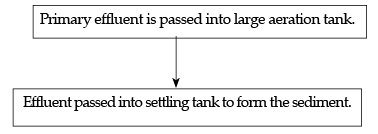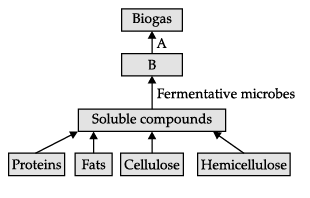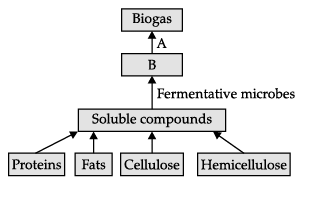Case Based Questions Test: Microbes in Human Welfare - NEET MCQ
15 Questions MCQ Test - Case Based Questions Test: Microbes in Human Welfare
Read the following text and answer the any four questions on the basis of the same:
Large quantities of sewage is generated every day in cities and towns, which is treated in Sewage Treatment Plants (STPs) to make it less polluted. Given below is the flow diagram of one of the stages of STP.
Observe the given flow diagram and answer the questions accordingly.

Q. Primary effluent is passed into large aeration tanks:

Read the following text and answer the any four questions on the basis of the same:
Large quantities of sewage is generated every day in cities and towns, which is treated in Sewage Treatment Plants (STPs) to make it less polluted. Given below is the flow diagram of one of the stages of STP.
Observe the given flow diagram and answer the questions accordingly.

Q. Identify the correct set of gases produced during digestion of sludge:

Read the following text and answer the any four questions on the basis of the same:
Large quantities of sewage is generated every day in cities and towns, which is treated in Sewage Treatment Plants (STPs) to make it less polluted. Given below is the flow diagram of one of the stages of STP.
Observe the given flow diagram and answer the questions accordingly.

Q. Technical term used for sediment formed in sewage treatment is:

Read the following text and answer the any four questions on the basis of the same:
Large quantities of sewage is generated every day in cities and towns, which is treated in Sewage Treatment Plants (STPs) to make it less polluted. Given below is the flow diagram of one of the stages of STP.
Observe the given flow diagram and answer the questions accordingly.

Q. The technology of biogas production from cow dung was developed in India largely due to the efforts of :
Read the following text and answer the any four questions on the basis of the same:
Large quantities of sewage is generated every day in cities and towns, which is treated in Sewage Treatment Plants (STPs) to make it less polluted. Given below is the flow diagram of one of the stages of STP.
Observe the given flow diagram and answer the questions accordingly.

Q. The significance of the above sediment formed is that:
Read the following text and answer any four questions on the basis of the same :
Ecological Indicators : The presence of dragonflies can reveal changes in the water ecosystems more quickly than studying other animals or plants. In fact, from the nymph to the adult stage, the dragonfly has a significant, positive ecological impact. Dragonfly eggs are laid and hatched in or near water, so their lives show an impact on both water and land ecosystems. Once hatched, dragonfly nymphs can breathe in the air or underwater which enables them to eat mosquito larvae, other aquatic insects and worms, and even small aquatic vertebrates like tadpoles and small fish. Adult dragonflies capture and eat adult mosquitoes.
Community wide mosquito control programs that spray insecticides to kill adult mosquitoes also kill dragonflies.
Q. The approach to biological control includes :
Read the following text and answer any four questions on the basis of the same :
Ecological Indicators : The presence of dragonflies can reveal changes in the water ecosystems more quickly than studying other animals or plants. In fact, from the nymph to the adult stage, the dragonfly has a significant, positive ecological impact. Dragonfly eggs are laid and hatched in or near water, so their lives show an impact on both water and land ecosystems. Once hatched, dragonfly nymphs can breathe in the air or underwater which enables them to eat mosquito larvae, other aquatic insects and worms, and even small aquatic vertebrates like tadpoles and small fish. Adult dragonflies capture and eat adult mosquitoes.
Community wide mosquito control programs that spray insecticides to kill adult mosquitoes also kill dragonflies.
Q. The most effective stages in the life cycle of dragonfly are eradicating mosquitoes area.
Read the following text and answer any four questions on the basis of the same :
Ecological Indicators : The presence of dragonflies can reveal changes in the water ecosystems more quickly than studying other animals or plants. In fact, from the nymph to the adult stage, the dragonfly has a significant, positive ecological impact. Dragonfly eggs are laid and hatched in or near water, so their lives show an impact on both water and land ecosystems. Once hatched, dragonfly nymphs can breathe in the air or underwater which enables them to eat mosquito larvae, other aquatic insects and worms, and even small aquatic vertebrates like tadpoles and small fish. Adult dragonflies capture and eat adult mosquitoes.
Community wide mosquito control programs that spray insecticides to kill adult mosquitoes also kill dragonflies.
Q. Two diseases less likely to occur in a region with plenty of dragonflies are_____
Read the following text and answer any four questions on the basis of the same :
Ecological Indicators : The presence of dragonflies can reveal changes in the water ecosystems more quickly than studying other animals or plants. In fact, from the nymph to the adult stage, the dragonfly has a significant, positive ecological impact. Dragonfly eggs are laid and hatched in or near water, so their lives show an impact on both water and land ecosystems. Once hatched, dragonfly nymphs can breathe in the air or underwater which enables them to eat mosquito larvae, other aquatic insects and worms, and even small aquatic vertebrates like tadpoles and small fish. Adult dragonflies capture and eat adult mosquitoes.
Community wide mosquito control programs that spray insecticides to kill adult mosquitoes also kill dragonflies.
Directions : In the following questions a statement of assertion (A) is followed by a statement of reason (R). Mark the correct choice as :
Assertion : Releasing dragonflies in areas where there is an outbreak of malarial diseases can be an environment friendly method of control.
Reason : Dragonflies are dominant species and will not allow mosquitoes to reproduce.
Read the following text and answer any four questions on the basis of the same :
Ecological Indicators : The presence of dragonflies can reveal changes in the water ecosystems more quickly than studying other animals or plants. In fact, from the nymph to the adult stage, the dragonfly has a significant, positive ecological impact. Dragonfly eggs are laid and hatched in or near water, so their lives show an impact on both water and land ecosystems. Once hatched, dragonfly nymphs can breathe in the air or underwater which enables them to eat mosquito larvae, other aquatic insects and worms, and even small aquatic vertebrates like tadpoles and small fish. Adult dragonflies capture and eat adult mosquitoes.
Community wide mosquito control programs that spray insecticides to kill adult mosquitoes also kill dragonflies.
Q. Dragonflies indicate positive ecological impact as :
Read the following and answer the question given below:
Villagers in a place near Chembur started planning to make power supply for agricultural purposes from cow dung. They have started a biogas plant for the purpose.
Study the flow chart for biogas production given below and answer the following questions.

Q. Biogas is composed of majorly:
Read the following and answer the following question:
Microorganisms include bacteria, viruses, fungi and protozoa. In our mind, we presume, most of the time, that microbes are always harmful. Microbes are, of course, the causal agents of many infections diseases of plants and animals including humans but they also have lots of beneficial role. Lactic acid bacteria (LAB) are one of this kind of useful group. These are Gram positive, non-sporulating, either rod shaped or spherical bacteria. They produce lactic acid in milk products as major metabolic end product of carbohydrate fermentation. LAB are considered as natural fermentors. Lactobacillus is a common LAB which converts lactose sugar of milk into lactic acid, that causes coagulation and partial digestion of milk protein casein. Milk is then changed into curd, yoghurt and cheese. Lactobacillus is also used in probiotics which have potentially beneficial effect on gut ecosystem of humans. Some other probiotic strain used belong to the Genus Bifidobacterium.
Q. Which of the following is not a lactic acid producing bacteria?
Read the following and answer the question given below:
Villagers in a place near Chembur started planning to make power supply for agricultural purposes from cow dung. They have started a biogas plant for the purpose.
Study the flow chart for biogas production given below and answer the following questions.

Q. In the given flow chart, 'A' denotes :
Read the following and answer the question given below:
Villagers in a place near Chembur started planning to make power supply for agricultural purposes from cow dung. They have started a biogas plant for the purpose.
Study the flow chart for biogas production given below and answer the following questions.

Q. If 'A' is not added in the procedure
Read the following and answer the question given below:
Villagers in a place near Chembur started planning to make power supply for agricultural purposes from cow dung. They have started a biogas plant for the purpose.
Study the flow chart for biogas production given below and answer the following questions.

Q. What is represented by 'B' in the flow chart?



















